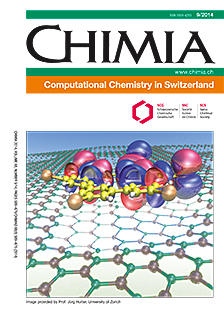Non-empirical Prediction of the Photophysical and Magnetic Properties of Systems with Open d- and f-Shells Based on Combined Ligand Field and Density Functional Theory (LFDFT)
DOI:
https://doi.org/10.2533/chimia.2014.633Keywords:
Density functional theory, Ligand field theory, Phosphors, Single ion magnets, Warm-white lightAbstract
Despite the important growth of ab initio and computational techniques, ligand field theory in molecular science or crystal field theory in condensed matter offers the most intuitive way to calculate multiplet energy levels arising from systems with open shells d and/or f electrons. Over the past decade we have developed a ligand field treatment of inorganic molecular modelling taking advantage of the dominant localization of the frontier orbitals within the metal-sphere. This feature, which is observed in any inorganic coordination compound, especially if treated by Density Functional Theory calculation, allows the determination of the electronic structure and properties with a surprising good accuracy. In ligand field theory, the theoretical concepts consider only a single atom center; and treat its interaction with the chemical environment essentially as a perturbation. Therefore success in the simple ligand field theory is no longer questionable, while the more accurate molecular orbital theory does in general over-estimate the metal–ligand covalence, thus yields wave functions that are too delocalized. Although LF theory has always been popular as a semi-empirical method when dealing with molecules of high symmetry e.g. cubic symmetry where the number of parameters needed is reasonably small (3 or 5), this is no more the case for molecules without symmetry and involving both an open d- and f-shell (# parameters ?90). However, the combination of LF theory and Density Functional (DF) theory that we introduced twenty years ago can easily deal with complex molecules of any symmetry with two and more open shells. The accuracy of these predictions from 1st principles achieves quite a high accuracy (<5%) in terms of states energies. Hence, this approach is well suited to predict the magnetic and photo-physical properties arbitrary molecules and materials prior to their synthesis, which is the ultimate goal of each computational chemist. We will illustrate the performance of LFDFT for the design of phosphors that produces light similar to our sun and predict the magnetic anisotropy energy of single ion magnets.Downloads
Published
2014-09-24
Issue
Section
Scientific Articles
License
Copyright (c) 2014 Swiss Chemical Society

This work is licensed under a Creative Commons Attribution-NonCommercial 4.0 International License.
How to Cite
[1]
Chimia 2014, 68, 633, DOI: 10.2533/chimia.2014.633.







